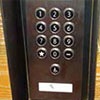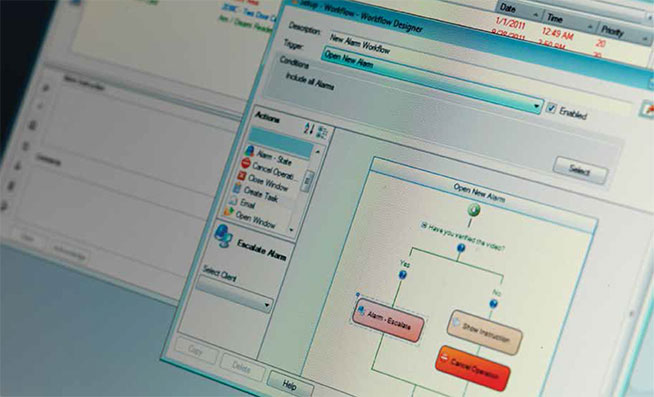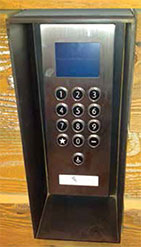
Streamline Traffic Flow
Large building chooses security systems and elevator controls that work together
- By Kim Rahfaldt
- Mar 01, 2013

Elevator destination control systems offer an efficient solution for highrise buildings looking to streamline traffic flow. The benefits include less elevator congestion, increased efficiency and happier tenants.
Building owners have found that integrating an elevator destination control system with its security management system enhances these benefits for tenants because they can use their credential for both access control and elevator access, but careful planning is a must to ensure cost effectiveness.
Make Wise Choices
Choosing the wrong elevator company could limit a building owner’s choices when it comes time to choose a security management system. Traditionally, building owners choose their elevator company early in the building design stage. A security system is typically researched, reviewed and selected much later in the design process.
Surprisingly, very few access control systems provide off-the-shelf integration with elevator destination dispatch systems, and a lack of early planning could later prove an expensive mistake. Building owners are finding they need to make their security system decision early in the design process if they want the elevator solution to affordably integrate with their chosen security solution.
Historically, building owners have paid security companies to write a one-of-a-kind software interface to their chosen security management system. The installation project needed to be large enough for the security company to dedicate its engineering resources to write the software. A typical software integration could cost a building owner as much as $50,000 and could take four months to install, which is an expensive and inefficient process.
“When we started educating building owners and developers about the importance and potential financial impact of their decisions, we advised they plan their security choices at the same time they were selecting their destination control elevator system,” said Jeff Smith, associate principal at TEECOM. “What we learned on multiple projects is that the building owner and design team did not understand the importance of identifying both system requirements early in the design process. Our projects were more successful when this integration was clearly addressed in specifications prior to the work being issued for bid.”
Building owners would select a destination control dispatch elevator system, such as ThyssenKrupp, Otis, Schindler or others, request a specific access control company’s system to protect their building. In many cases, an existing off-the-shelf software interface was not available and an unbudgeted project cost was required.
 Building owners care about operating their buildings as efficiently and inexpensively as possible, in addition to attractive, energy-efficient buildings that will draw tenants. One advantage is fast, proficient elevators. Building owners generally do not require complex security systems to provide the required level of safety and security for the base building. Therefore, if a mainstream security management system offers an off-the-shelf—not customized for the individual project—software integration with a building owner’s new destination control system, it’s a big cost advantage and timesaver.
Building owners care about operating their buildings as efficiently and inexpensively as possible, in addition to attractive, energy-efficient buildings that will draw tenants. One advantage is fast, proficient elevators. Building owners generally do not require complex security systems to provide the required level of safety and security for the base building. Therefore, if a mainstream security management system offers an off-the-shelf—not customized for the individual project—software integration with a building owner’s new destination control system, it’s a big cost advantage and timesaver.
“Overall, many security system manufacturers follow the traditional model of requiring a new project, time and money to prior developing an interface for a project,” Smith said. “Others are investing in development of software integrations to the leading destination elevator control systems today. I believe this proactive approach will allow those industry leaders to respond quicker to the customer’s needs, for a lower cost and increase their competitiveness on projects using destination control elevators.”
A few access control companies have developed integrations with one of the major elevator companies. If a building owner selects the right combination, it works. But if a building owner has invested in its elevator system and then desires a particular security management system, research will be required to determine if the two systems will integrate.
Access control companies need to follow the new software business model of investing the money upfront and writing the integrations so they are readily available. The access control company can then resell its integration and better market itself to property management companies and building owners.
“AMAG Technology recognized an opportunity to provide property management companies with a solution that integrates with four of the six major elevator companies’ destination dispatch systems,” Smith said. “They took the gamble and are now in a strong position in the marketplace.”
How it Works
The traditional method of interfacing access control systems with elevator control systems limits access for authorized users to designated floors in a building. The interface uses relay-based logic where relay outputs are hardwired to elevator system inputs. When a valid card is presented to the card reader located inside the elevator cab on the car operating panel, selected relay outputs would then become active for floors to which the card holder has access.
Using a destination dispatch system integrated with a security system, there is a keypad with an integrated card reader, instead of a hall call station. It is located outside of the elevator. Passengers enter the information and they keypad indicates what cab to get in, allowing the person to transport through the building. Passengers must swipe their card and punch in their destination floor before entering the elevator cab.
Passengers are grouped together by destination and directed to the same elevator. This reduces waiting and travel times when compared to traditional elevator operation.
Benefits for the Building Owner
Destination Dispatch moves people faster through a building and creates less congestion and fast throughput of building tenants and guests. Lobbies are cleaner, sleeker and appear more open and attractive.
A building will use fewer elevators, lowering operation costs and energy consumption. This saves money and increases profits.
Integrated destination dispatch and security system raises competition in the marketplace. Buildings that move people faster and more efficiently throughout the building attract long-term tenants. High-rise buildings want every amenity and advantage they can afford in order to obtain long-term tenants.
Another advantage is that a solid elevator dispatch solution helps buildings meet LEED requirements. High rise buildings must often demonstrate a building as “green.” LEED certification provides proof a building has met its environmental goals and allows building owners to take advantage of state and local government incentives. Buildings can achieve a Certified, Silver, Gold or Platinum level rating that can be accrued in five categories: sustainable sites, water efficiency, energy and atmosphere, material and resources and indoor and environmental quality. Having an integrated elevator control and security management system saves on energy consumption.
Overall, it is in the best interest of the building owner to consider which security management system they would like to install in conjunction with which elevator control system to use. Choosing the two systems together will allow proper analysis of important features for both systems and provide a clear understanding of which elevator system integrations are available. Although it’s more upfront work, it will save time, money and headaches in the long run.
This article originally appeared in the March 2013 issue of Security Today.